 W
WAdrianople, a major Byzantine city in Thrace, was conquered by the Ottomans sometime in the 1360s, and eventually became the Ottoman capital, until the Fall of Constantinople in 1453.
 W
WThe Siege of Aleppo was a siege of the Hamdanid capital Aleppo by the army of the Fatimid Caliphate under Manjutakin from the spring of 994 to April 995. Manjutakin laid siege to the city over the winter, while the population of Aleppo starved and suffered from disease. In the spring of 995, the emir of Aleppo appealed for help from Byzantine emperor Basil II. The arrival of a Byzantine relief army under the emperor in April 995 compelled the Fatimid forces to give up the siege and retreat south.
 W
WThe major Mediterranean port of Alexandria, the capital of the Byzantine province of Egypt, was permanently seized from the Byzantine Empire by forces of the Rashidun Caliphate in the middle of the 7th Century AD. This marked the end of Eastern Roman maritime power over the Eastern Mediterranean and thus brought about a decisive geopolitical shift, also spreading the Rashidun's control further.
 W
WThe Sack of Amorium by the Abbasid Caliphate in mid-August 838 was one of the major events in the long history of the Arab–Byzantine Wars. The Abbasid campaign was led personally by the Caliph al-Mu'tasim, in retaliation to a virtually unopposed expedition launched by the Byzantine emperor Theophilos into the Caliphate's borderlands the previous year. Mu'tasim targeted Amorium, a Byzantine city in western Asia Minor, because it was the birthplace of the ruling Byzantine dynasty and, at the time, one of Byzantium's largest and most important cities. The caliph gathered an exceptionally large army, which he divided in two parts, which invaded from the northeast and the south. The northeastern army defeated the Byzantine forces under Theophilos at Anzen, allowing the Abbasids to penetrate deep into Byzantine Asia Minor and converge upon Ancyra, which they found abandoned. After sacking the city, they turned south to Amorium, where they arrived on 1 August. Faced with intrigues at Constantinople and the rebellion of the large Khurramite contingent of his army, Theophilos was unable to aid the city.
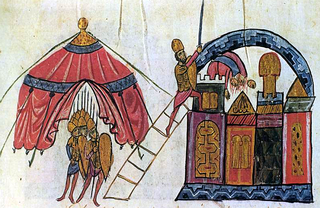 W
WThe Siege of Antioch (968–969) was a successful military offensive undertaken by leading commanders of the Byzantine Empire in order to reconquer the strategically important city of Antioch from the Hamdanid Dynasty.
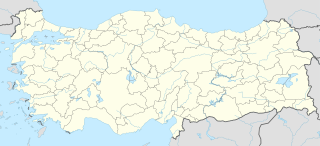 W
WThe Battle of Alexandretta was the first clash between the forces of the Byzantine Empire and the Fatimid Caliphate in Syria. It was fought in early 971 near Alexandretta, while the main Fatimid army was besieging Antioch, which the Byzantines had captured two years previously. The Byzantines, led by one of Emperor John I Tzimiskes' household eunuchs, lured a 4,000-strong Fatimid detachment to attack their empty encampment and then attacked them from all sides, destroying the Fatimid force. The defeat at Alexandretta, coupled with the Qarmatian invasion of southern Syria, forced the Fatimids to lift the siege and secured Byzantine control of Antioch and northern Syria.
 W
WThe Siege of Antioch took place during the First Crusade in 1097 and 1098. The first siege, by the crusaders against the Muslim-held city, lasted from 21 October 1097 to 2 June 1098. Antioch lay in a strategic location on the crusaders' route to Palestine. Supplies, reinforcements and retreat could all be controlled by the city. Anticipating that it would be attacked, the Muslim governor of the city, Yaghi-Siyan, began stockpiling food and sending requests for help. The Byzantine walls surrounding the city presented a formidable obstacle to its capture, but the leaders of the crusade felt compelled to besiege Antioch anyway.
 W
WThe Battle of Kapetron or Kapetrou was fought between a Byzantine-Georgian army and the Seljuq Turks at the plain of Kapetron in 1048. The event was the culmination of a major raid led by the Seljuq prince Ibrahim Inal into Byzantine-ruled Armenia. A combination of factors meant that the regular Byzantine forces were at a considerable numerical disadvantage against the Turks: the local thematic armies had been disbanded, while many of the professional troops had been diverted to the Balkans to face the revolt of Leo Tornikios. As a result, the Byzantine commanders, Aaron and Katakalon Kekaumenos, disagreed on how best to confront the invasion. Kekaumenos favoured an immediate and pre-emptive strike, while Aaron favoured a more cautious strategy until the arrival of reinforcements. Emperor Constantine IX chose the latter option and ordered his forces to adopt a passive stance, while requesting aid from the Georgian ruler Liparit IV. This allowed the Turks to ravage at will, notably leading to the sack and destruction of the great commercial centre of Artze.
 W
WThe Babylon Fortress, a major military stronghold of the Byzantine Empire in Egypt, was captured by forces of the Rashidun Caliphate after a prolonged siege in 640. It was a major event during the Muslim conquest of Egypt.
 W
WThe Siege of Berat in Albania by the forces of the Angevin Kingdom of Sicily against the Byzantine garrison of the city took place in 1280–1281. Berat was a strategically important fortress, whose possession would allow the Angevins access to the heartlands of the Byzantine Empire. A Byzantine relief force arrived in spring 1281, and managed to ambush and capture the Angevin commander, Hugo de Sully. Thereupon, the Angevin army panicked and fled, suffering heavy losses in killed and wounded as it was attacked by the Byzantines. This defeat ended the threat of a land invasion of the Byzantine Empire, and along with the Sicilian Vespers marked the end of the Western threat to reconquer Byzantium.
 W
WThe Siege of Prusa occurred from 1317/20 until the capture on 6 April 1326, when the Ottomans deployed a bold plan to seize Prusa. The Ottomans had not captured a city before; the lack of expertise and adequate siege equipment at this stage of the war meant that the city fell only after six or nine years.
 W
WThe Siege of Chandax was the centerpiece of the Byzantine Empire's campaign to recover the island of Crete, which since the 820s had been ruled by Muslim Arabs. The campaign followed a series of failed attempts to reclaim the island from the Muslims stretching as far back as 827, only a few years after the initial conquest of the island by the Arabs, and was led by the general and future emperor Nikephoros Phokas. It lasted from autumn 960 until spring 961, when the main Muslim fortress and capital of the island, Chandax was captured. The reconquest of Crete was a major achievement for the Byzantines, as it restored Byzantine control over the Aegean littoral and diminished the threat of Saracen pirates, for which Crete had provided a base of operations.
 W
WThe Siege of Constantinople in 626 by the Sassanid Persians and Avars, aided by large numbers of allied Slavs, ended in a strategic victory for the Byzantines. The failure of the siege saved the Empire from collapse, and, combined with other victories achieved by Emperor Heraclius the previous year and in 627, enabled Byzantium to regain its territories and end the destructive Roman–Persian Wars by enforcing a treaty with borders status quo c. 590.
 W
WThe First Arab Siege of Constantinople in 674–678 was a major conflict of the Arab–Byzantine wars, and the first culmination of the Umayyad Caliphate's expansionist strategy towards the Byzantine Empire, led by Caliph Mu'awiya I. Mu'awiya, who had emerged in 661 as the ruler of the Muslim Arab empire following a civil war, renewed aggressive warfare against Byzantium after a lapse of some years and hoped to deliver a lethal blow by capturing the Byzantine capital, Constantinople.
 W
WThe Second Arab Siege of Constantinople in 717–718 was a combined land and sea offensive by the Muslim Arabs of the Umayyad Caliphate against the capital city of the Byzantine Empire, Constantinople. The campaign marked the culmination of twenty years of attacks and progressive Arab occupation of the Byzantine borderlands, while Byzantine strength was sapped by prolonged internal turmoil. In 716, after years of preparations, the Arabs, led by Maslama ibn Abd al-Malik, invaded Byzantine Asia Minor. The Arabs initially hoped to exploit Byzantine civil strife and made common cause with the general Leo III the Isaurian, who had risen up against Emperor Theodosius III. Leo, however, tricked them and secured the Byzantine throne for himself.
 W
WThe Siege of Constantinople of 1411 occurred during the Ottoman Interregnum, or Ottoman Civil War,, when chaos reigned in the Ottoman Empire following the defeat of Sultan Bayezid I by the Central Asian warlord Timur. Although Mehmed Çelebi was confirmed as sultan by Timur after the Battle of Ankara, his brothers İsa Çelebi, Musa Çelebi, Süleyman Çelebi, and later, Mustafa Çelebi, refused to recognize his authority, each claiming the throne for himself. A civil war was the result. The Interregnum lasted until the Battle of Camurlu on 5 July 1413, when Mehmed Çelebi emerged as victor in the strife, crowned himself sultan Mehmed I, and restored peace to the empire.
 W
WThe first full-scale Ottoman Siege of Constantinople took place in 1422 as a result of the Byzantine Emperor Manuel II's attempts to interfere in the succession of Ottoman Sultans, after the death of Mehmed I in 1421. This policy of the Byzantines was often used successfully in weakening their neighbours.
 W
WThe Fall of Constantinople was the capture of the Byzantine Empire's capital by the Ottoman Empire. The city fell on 29 May 1453, the culmination of a 53-day siege which had begun on 6 April 1453.
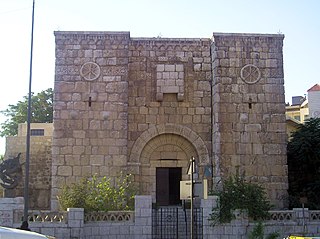 W
WThe Siege of Damascus (634) lasted from 21 August to 19 September 634 before the city fell to the Rashidun Caliphate. Damascus was the first major city of the Eastern Roman Empire to fall in the Muslim conquest of Syria.
 W
WThe Siege of Dara was raised by the Sasanian king Khosrow I in 573 during the Byzantine–Sasanian War of 572–591. The fortified city fell after 4 months.
 W
WThe Battle of Dorostopol was fought in 971 between the Byzantine Empire and forces of Kievan Rus'. The Byzantines, led by John I Tzimisces, were victorious.
 W
WThe Siege of Euripos occurred in the mid-880s, when an Abbasid fleet, led by the emir of Tarsos, Yazaman al-Khadim, laid siege to the city. The local Byzantine commander, Oiniates, successfully defended the city and destroyed a large part of the besieging force.
 W
WThe Siege of Jerusalem was part of a military conflict which took place in the year 636-637/38 between the Byzantine Empire and the Rashidun Caliphate. It began when the Rashidun army, under the command of Abu Ubaidah, besieged Jerusalem beginning in November 636. After six months, the Patriarch Sophronius agreed to surrender, on condition that he submit only to the Caliph. In 637 or 638, Caliph Umar traveled to Jerusalem in person to receive the submission of the city. The Patriarch thus surrendered to him.
 W
WThe siege of Kamacha by the Abbasid Caliphate took place in autumn 766, and involved the siege of the strategically important Byzantine fortress of Kamacha on the eastern bank of the Euphrates River, as well as a large-scale raid across eastern Cappadocia by a part of the Abbasid invasion army. Both enterprises failed, with the siege dragging on into winter before being abandoned and the raiding force being surrounded and heavily defeated by the Byzantines. The campaign was one of the first large-scale Abbasid operations against Byzantium, and is one of the few campaigns of the Arab–Byzantine wars for which detailed information survives, although it is barely mentioned in Arabic or in Byzantine sources.
 W
WThe Siege of Lovech took place in the spring of 1187 between the forces of Bulgaria and the Byzantine Empire.
 W
WThe Siege of Medina was an unsuccessful Byzantine attack on the Muslim city of Medina, Malta in 1053 or 1054. The Muslim inhabitants of the city and their slaves managed to repel a superior Byzantine force, which retreated with heavy losses. After the siege, the slaves who helped the Muslims against the invaders were freed, and the Byzantines never attempted to retake the island.
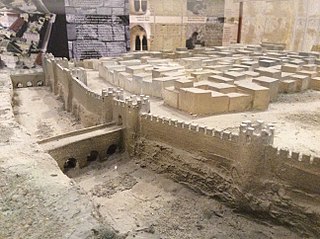 W
WThe Siege of Melite was the capture of the Byzantine city of Melite by an invading Aghlabid army in 870 AD. The siege was initially led by Halaf al-Hādim, a renowned engineer, but he was killed and replaced by Sawāda Ibn Muḥammad. The city withstood the siege for some weeks or months, but it ultimately fell to the invaders, and its inhabitants were massacred and the city was sacked.
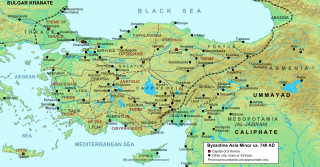 W
WThe Siege of Nicaea of 727 was an unsuccessful attempt by the Umayyad Caliphate to capture the Byzantine city of Nicaea, the capital of the Opsician Theme. Ever since its failure to capture the Byzantine Empire's capital, Constantinople, in 717–718, the Caliphate had launched a series of raids into Byzantine Asia Minor. In 727, the Arab army, led by one of the Caliph's sons, penetrated deep into Asia Minor, sacked two Byzantine fortresses and in late July arrived before Nicaea. Despite constant attacks for 40 days, the city held firm and the Arabs withdrew and returned to the Caliphate. The successful repulsion of the attack was a major boost for Byzantine emperor Leo III the Isaurian's recently initiated campaign to abolish the veneration of icons in the Empire; Leo claimed it as evidence of divine favour for his policy. The siege of Nicaea marks also the high point of the Umayyad raids, as new threats and defeats on their far-flung frontiers decreased Umayyad strength elsewhere, while Byzantine power strengthened afterwards.
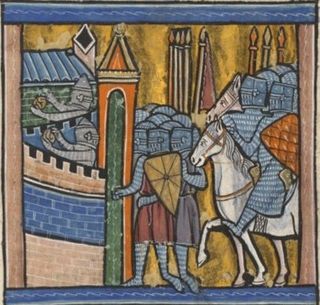 W
WThe Siege of Nicaea took place from May 14 to June 19, 1097, during the First Crusade. The city belonged to the Seljuk Turks and opted to surrender to the Byzantines in fear of the crusaders breaking into the city. The siege was followed by the Battle of Dorylaeum, and the siege of Antioch, all of which are in modern Turkey.
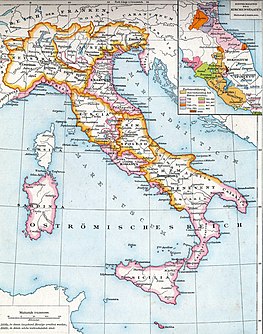 W
WThe Lombards or Langobards were a Germanic people who ruled most of the Italian Peninsula from 568 to 774.
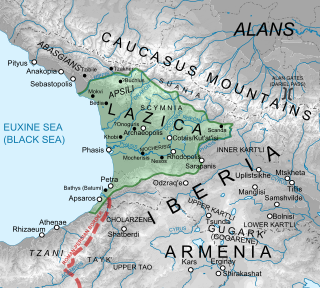 W
WThe Siege of Phasis took place in 555–556 during the Lazic War between the Byzantine and Sasanian Empires. Expecting an easy victory, the Persians besieged the town of Phasis in Lazica, held by the Byzantines, but were defeated in the ensuing irregular battle. The main source for the siege is the 6th-century historian Agathias.
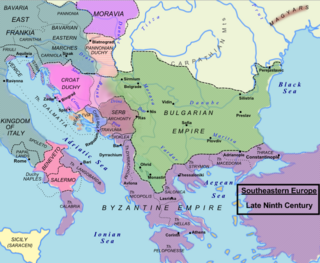 W
WThe Siege of Ragusa by the Aghlabids of Ifriqiya lasted for fifteen months, beginning in 866 until the lifting of the siege at the approach of a Byzantine fleet in 868. The failure of the siege and the re-appearance of the Byzantines in the region of Dalmatia signalled the beginning of new aggressive western policy by the new Byzantine emperor, Basil I. Its immediate effects were the re-establishment of Byzantine authority there in the form of the Theme of Dalmatia, and the beginning of the Christianization of the Slavs of the western Balkans, but within a few years it led to renewed Byzantine involvement and presence in southern Italy as well.
 W
WThe Sack of Rome in 546 was carried out by the Gothic king Totila during the Gothic War of 535–554 between the Ostrogoths and the Byzantine Empire. Totila was based at Tivoli and, in pursuit of his quest to reconquer the region of Latium, he moved against Rome. The city endured a siege lasting almost a year before falling to the Goths.
 W
WThe city of Rome was besieged in AD 549–550 by the Ostrogoths, led by Totila, during a campaign to recapture Italy from the Byzantine Empire. After Totila imposed a blockade, soldiers from the city's garrison opened the gates to him. Many of the male inhabitants were killed in the city or while attempting to flee. The city was afterwards repopulated and rebuilt.
 W
WThe Siege of Rometta was a siege of the Byzantine city of Rometta in northeastern Sicily by the Kalbids, on behalf of the Fatimid Dynasty in order to complete the Muslim conquest of Sicily.
 W
WThe Sasanian Empire conquered Jerusalem after a brief siege in 614, during the Byzantine–Sasanian War of 602–628, after the Persian Shah Khosrau II appointed his general Shahrbaraz to conquer the Byzantine controlled areas of the Near East. Following the victory in Antioch, Shahrbaraz conquered Caesarea Maritima, the administrative capital of the province. By this time the grand inner harbor had silted up and was useless, however the Emperor Anastasius had reconstructed the outer harbor and Caesarea remained an important maritime city, providing the Persian Empire with access to the Mediterranean Sea. The Sasanian Persians were joined by Nehemiah ben Hushiel and Benjamin of Tiberias, who enlisted and armed Jewish soldiers from Tiberias, Nazareth and the mountain cities of Galilee, and together with a band of Arabs and additional Jews from southern parts of the country they marched on Jerusalem. Some 20,000 Jewish rebels joined the war against the Byzantine Christians. Depending on the chronicler figures of either 20,000 or 26,000 are given. The Persian army reinforced by Jewish forces led by Nehemiah ben Hushiel and Benjamin of Tiberias would capture Jerusalem–without resistance, or after a siege and breaching the wall with artillery, depending on the source.
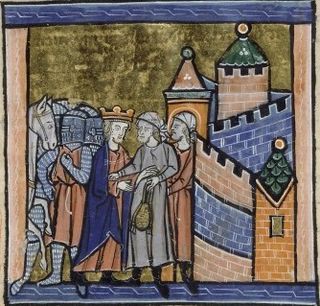 W
WThe Siege of Shaizar took place from April 28 to May 21, 1138. The allied forces of the Byzantine Empire, Principality of Antioch and County of Edessa invaded Muslim Syria. Having been repulsed from their main objective, the city of Aleppo, the combined Christian armies took a number of fortified settlements by assault and finally besieged Shaizar, the capital of the Munqidhite Emirate. The siege captured the city, but failed to take the citadel; it resulted in the Emir of Shaizar paying an indemnity and becoming the vassal of the Byzantine emperor. The forces of Zengi, the greatest Muslim prince of the region, skirmished with the allied army but it was too strong for them to risk battle. The campaign underlined the limited nature of Byzantine suzerainty over the northern Crusader states and the lack of common purpose between the Latin princes and the Byzantine emperor.
 W
WThe Siege of Sirmium in 580–582 was a decisive event in the history of the Balkans. The fall of the city to the Avars deprived the Byzantine Empire of its major stronghold on the northwestern Danube, opening the path for devastating incursions by the Avars and their Slavic allies into the Balkans.
 W
WThe Siege of Syracuse in 877–878 led to the fall of the city of Syracuse, the Roman capital of Sicily, to the Aghlabids. The siege lasted from August 877 to 21 May 878, when the city, effectively left without assistance by the central Byzantine government, was sacked by the Aghlabid forces.
 W
WThe Siege of Thessalonica in 617 or 618 was an unsuccessful siege of the city of Thessalonica, the major Byzantine stronghold in the region, by the Avars and the Slavic tribes (Sclaveni) who had settled in the city's vicinity. The attack was the last and best-organized attempt by the Avars to take the city. It lasted 33 days and involved the use of siege engines, but in the end failed. The main source for these events are the Miracles of Saint Demetrius, named after Thessalonica's patron saint, Saint Demetrius.
 W
WThe Sack of Thessalonica refers to the capture, and subsequent sack, of the city of Thessalonica by the Abbasid Caliphate in the year 904, led by Leo of Tripoli, a privateer and Muslim convert.
 W
WThe siege of Thessalonica between 1422 and 1430 saw the Ottoman Empire under Sultan Murad II capture the city of Thessalonica, which remained in Ottoman hands for the next five centuries, until it became part of the Kingdom of Greece in 1912.
 W
WThe Siege of Tyana was carried out by the Umayyad Caliphate in 707–708 or 708–709 in retaliation for a heavy defeat of an Umayyad army under Maimun the Mardaite by the Byzantine Empire in c. 706. The Arab army invaded Byzantine territory and laid siege to the city in summer 707 or 708. The date is uncertain, as virtually each of the extant Greek, Arabic, and Syriac parallel sources has in this respect a different date. Tyana initially withstood the siege with success, and the Arab army faced great hardship during the ensuing winter and was on the point of abandoning the siege in spring, when a relief army sent by Emperor Justinian II arrived. Quarrels among the Byzantine generals, as well as the inexperience of a large part of their army, contributed to a crushing Umayyad victory. Thereupon the inhabitants of the city were forced to surrender. Despite the agreement of terms, the city was plundered and largely destroyed, and according to Byzantine sources its people were made captive and deported, leaving the city deserted.